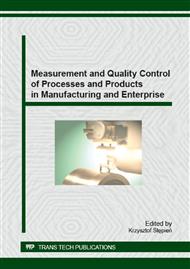p.1
p.7
p.13
p.21
p.27
p.37
p.45
p.57
p.69
Qualifying Measuring Systems by Using Six Sigma
Abstract:
The technology of sheet-bulk metal forming enables the production of complex workpieces with filigree surface structures in only a few forming steps. In order to provide a rapid and production-related workpiece inspection of not only large workpiece features, but also small features in an appropriate quality, a multi-sensor optical measurement system with different resolutions is required. Workpiece features of medium size can be measured by two types of fringe projection sensors. With a structured approach according to Six Sigma, which is based on the five phases design, measure, analyze, improve and control complex tasks are divided into smaller individual problems. In each phase the Six Sigma method recommends tools for solving the individual problems effectively. With the support of the Six Sigma guideline an exemplary sheet-bulk metal forming workpiece feature is used in order to qualify the two measuring systems for a production-related measurement. After defining the explicit goal for the investigations, a detailed analysis of the measurement process leads to a couple of relevant influences. These are input factors for the design of experiments. By a full factorial design, not only an influence of a factor itself, also the interactions between multiple factors can be detected. In the analyze-phase, these results are calculated by different statistical methods. To present the results in a comprehensible way several types of diagrams are used. The shown approach gives an example for a traceable and methodical way to qualify a measurement system for challenging measurement tasks.
Info:
Periodical:
Pages:
37-43
Citation:
Online since:
February 2015
Authors:
Price:
Сopyright:
© 2015 Trans Tech Publications Ltd. All Rights Reserved
Share:
Citation:


